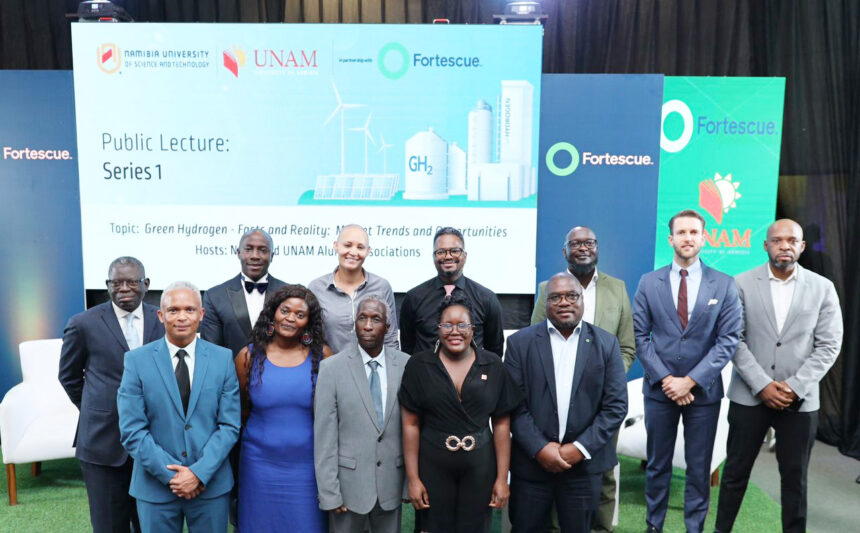The University of Namibia (UNAM) and Namibia University of Science and Technology (NUST) Alumni Association, in collaboration with Fortescue Namibia, recently hosted a panel discussion titled “Green Hydrogen Facts and Reality: Market Trends and Opportunities”. The panel brought together experts in the green hydrogen sector, leaders and the universities’ alumni.
The panel discussion at the NUST auditorium was moderated by journalist Denver Kisting, and featured green hydrogen experts including Bernard Moulins, Fortescue Head of Strategy & Commercial; James Mnyupe, Green Hydrogen Commissioner of Namibia; Toni Beukes, Head of Environment, Social & Governance (ESG) at Hyphen Hydrogen Energy Namibia; and Zivayi Chiguvare, acting director of the Namibia Green Hydrogen Research Institute (NGHRI).
The panel centred on the prospects, challenges and economics surrounding the green hydrogen sector, and offered a platform for stakeholders to discuss ideas that will contribute to Namibia’s green energy future. Attendees included government officials, industry stakeholders, investors, academic researchers, institutions and civil society organisations.
The event marked a key step forward in increasing public understanding of the opportunities presented by green hydrogen, and drew over 500 attendees, the largest gathering at NUST auditorium to date.
The event provided key context for the Global African Hydrogen Summit 2024, which commenced in the capital yesterday.
The panel discussion offered a global market perspective and exploring avenues for private sector involvement, industrial transformation plans, and the conditions necessary for large-scale project viability. The event served as a platform for stakeholders to discuss practical solutions aimed at propelling Namibia toward a green industrial future.
Moulins provided an in-depth analysis of the global green hydrogen market, discussing emerging trends, demand drivers, and opportunities for engagement. Drawing from Fortescue’s experience in green hydrogen development, he highlighted the critical role of strategic partnerships in unlocking significant value. He stated, “We (Fortescue) are driving forward an agenda that is very challenging and very innovative because there’s a belief that it’s going to unlock significant value.
It’s about selecting the right partners, suppliers, developers, off-takers, investors, government, universities and scientists.”
Mnyupe expressed his appreciation for Fortescue’s collaboration with local institutions, emphasising the importance of welcoming private sector investment to foster growth in the sector. “If I wanted more investment from the private sector, the best thing I can do is to make sure that they’re welcome. This dialogue which Fortescue has so generously facilitated, we need to now invest in repeating these messages across the country over and over and over.” He also addressed the strategic use of land, stressing the need for a balanced approach that supports both socioeconomic development and ecological preservation. “How we allocate and use the land to create a socioeconomically-thriving country and also an ecological haven for the flora and fauna that we have, is up to us. We can see that there will be a significant battle for the hearts and minds of Namibians to debate and deliberate on how to allocate the land that we have.”
Mnyupe further discussed the Namibian government’s ongoing efforts to draft a policy on synthetic fuels, offering insight based on successful models in Mauritania and Egypt. He underscored the importance of creating a competitive environment to attract new industries. “(We) must recognise that the world is competing for an opportunity to produce a clean molecule that can attract new industries to your country, and create new jobs and products. (Namibia) must incentivise and support (these industries) through legislation, but also through infrastructure provision.”
Beukes highlighted the transformative potential of the green hydrogen sector, while stressing the importance of environmental stewardship. She emphasised that the industry can coexist with natural ecosystems if projects are designed with biodiversity in mind. “There’s an Environmental Management Act, and we (HYPHEN Namibia) have already gone into the park and looked at what are the highest, medium, and least-sensitive from a biodiversity perspective, based on that plan, and the ecosystem of that area is absolutely informing how we design the project.”


